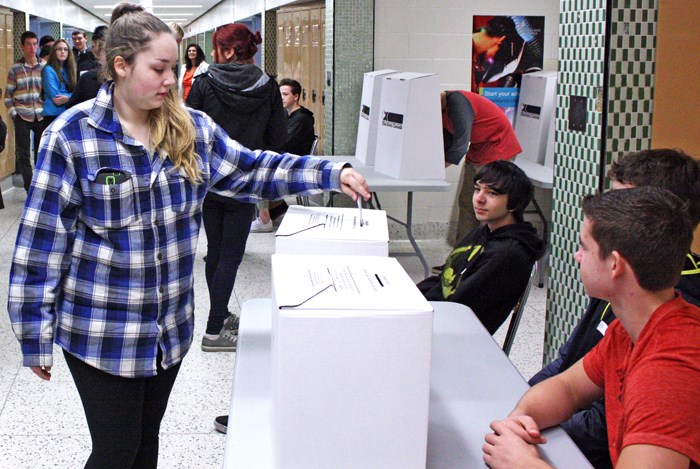“It’s pretty cool that we, as young children, get to do this and it’s pretty interesting we get to vote as Grade nines, and Grades 10, 11 and 12s,”
— Graham Buckle, Grade 9
Voter turnout in Canadian elections has been declining for decades. Evidence suggests that is because young people have been disengaging from politics and when they get in the habit of not voting, it tends to persist over time.
Since 2003, CIVIX—an independent, not-for-profit civic education organization—has been working with Elections Canada to change that.
On October 16, students in Yorkton participated in a mock election.
“This is just kind of trying to get students, in other words young people, familiar with the process, which will hopefully get them involved in the process when they turn 18,” explained Perry Ostapowich, a history teacher at Yorkton Regional High School.”
In the last federal election, more than 563,000 students from 3,750 schools (approximately one-third of the nation’s schools) cast ballots. There have been a total of 26 such exercises at federal, provincial and municipal elections since the program’s inception.
The student election mimics a real election in every way.
Elections Canada provides the ballots, which are identical to those actual voters see on election day, as well as, voting screens and ballot boxes.
At YRHS, Ostapowich’s senior classes became the returning officers and poll workers.
Every detail is the same, even the fact that students can choose not to vote if they wish.
Ostapowich offered anecdotal evidence the program is working.
“I think it is, for example, simply in the hall this morning I heard one student explaining to another student some of the posters we have on the wall, who to vote for,” he said. “What the student thought they were voting for was the leaders of the parties, but this student was explaining to the other student, no, it’s your local candidate, which is the system.”
Ostapowich’s instincts are backed up to a certain extent by an independent analysis of the 2011 federal election student vote commissioned by Elections Canada.
The results of the study indicated participants had an increased knowledge of politics and a better understanding of voting as a civic duty.
Furthermore, it suggested 60 per cent of parents of kids who participated reported their own interest and knowledge of politics increased. Of those, 20 per cent said it positively affected their decision to vote.
Graham Buckle, a Grade 9 student at the high school said it would “definitely” influence him to vote when he reaches 18.
“It’s pretty cool that we, as young children, get to do this and it’s pretty interesting we get to vote as Grade nines, and Grades 10, 11 and 12s,” he said, adding it was a good learning experience regarding how the voting process works.
There is no data, however, at least so far, that the exercise actually leads to an increase in youth voting and it may be difficult to separate the impact from other factors that influence voter turnout.
For example, Elections Canada has noted that Advance polls this year enjoyed a 75 per cent increase in turnout over the last election, but it is unclear what the impact them falling on a holiday weekend was.
The results of the student vote in 2011, do suggest that young voters could have a significant impact in tight races. The actual results of the 2011 election gave Stephen Harper’s Conservatives a solid majority of 166 seats with 39.6 per cent of the popular vote, the NDP the opposition with 103 seats and 30.6 per cent and the Liberals 34 seats with 18.9 per cent. Both the NDP and Liberals did better in the student vote with 113 and 47 seats respectively while the Conservatives were reduced to a minority government with 130 seats.
The question over youth engagement sometimes sparks debate about lowering the voting age to 16. Some countries, mainly in Central and South America, have already done so. In Europe, Austria and Bosnia allow 16-year-olds to vote.
In 2014, the Scottish National Party passed legislation allowing 16-year-olds to vote in the referendum to secede from the United Kingdom, a move that attracted great attention from then-Quebec premier Pauline Marois. Predictably, the suggestion sparked criticism of political opportunism because Quebec youth traditional tend to be more secessionist than their elders.
Periodically, the idea does come up nationally in Canada. Ostapowich said he did not think it was a bad idea to examine the issue.
“I think if there’s a precedent there in other democracies and I think that would, obviously, be something that has to be looked into in Canada, but I think the younger you get young kids involved and in this case, if it’s 16, young adults, you have to think if you’re old enough to drive, which is quite a responsibility, you would think you should be old enough to understand our society and vote,” he said.




